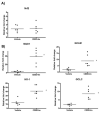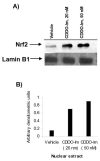Preclinical evaluation of targeting the Nrf2 pathway by triterpenoids (CDDO-Im and CDDO-Me) for protection from LPS-induced inflammatory response and reactive oxygen species in human peripheral blood mononuclear cells and neutrophils
- PMID: 17822364
- PMCID: PMC2396226
- DOI: 10.1089/ars.2007.1745
Preclinical evaluation of targeting the Nrf2 pathway by triterpenoids (CDDO-Im and CDDO-Me) for protection from LPS-induced inflammatory response and reactive oxygen species in human peripheral blood mononuclear cells and neutrophils
Abstract
Sepsis is characterized by an inappropriate host immune-inflammatory response and sustained oxidative damage. Nrf2, a bZIP oxidant-responsive transcription factor, regulates a battery of cytoprotective genes including antioxidants and maintains cellular redox homeostasis. Mouse studies have demonstrated a critical role of Nrf2 in improving survival during sepsis. This preclinical ex vivo study using neutrophils and peripheral blood mononuclear cells (PBMCs) as a surrogate cells evaluates the efficacy of CDDO-Im and CDDO-Me [imidazole and methyl ester derivative of 2-cyano-3,12-dioxooleana-1,9(11)-dien-28-oic acid (CDDO)] to activate the Nrf2 pathway and protect from lipopolysaccharide (LPS)-induced inflammatory response in humans. CDDO-Im treatment significantly induced Nrf2-dependent antioxidative genes (HO-1, GCLC, GCLM, and NQO1) in PBMCs isolated from six normal subjects. CDDO-Im increased nuclear accumulation of Nrf2 protein. Pretreatment of PBMC by CDDO-Im significantly attenuated LPS-induced cytokine expression. Similar increases in levels of antioxidant genes and suppression of LPS-induced cytokine expression was observed after CDDO-Me pretreatment. CDDO-Im also greatly inhibited LPS, fMLP, TNF-alpha, and TPA-induced ROS generation in neutrophils. In conclusion, these results demonstrate that activation of the Nrf2-dependent antioxidative pathway by CDDO-Im or CDDO-Me protects against the LPS-induced inflammatory response and suggest that they can be potential therapeutic candidates for intervening sepsis syndrome.
Figures






Similar articles
-
Nrf2-dependent protection from LPS induced inflammatory response and mortality by CDDO-Imidazolide.Biochem Biophys Res Commun. 2006 Dec 29;351(4):883-9. doi: 10.1016/j.bbrc.2006.10.102. Epub 2006 Oct 30. Biochem Biophys Res Commun. 2006. PMID: 17097057 Free PMC article.
-
The effect of ex vivo CDDO-Me activation on nuclear factor erythroid 2-related factor 2 pathway in white blood cells from patients with septic shock.Shock. 2014 Nov;42(5):392-9. doi: 10.1097/SHK.0000000000000236. Shock. 2014. PMID: 25105464 Free PMC article.
-
The synthetic triterpenoid CDDO-methyl ester modulates microglial activities, inhibits TNF production, and provides dopaminergic neuroprotection.J Neuroinflammation. 2008 May 12;5:14. doi: 10.1186/1742-2094-5-14. J Neuroinflammation. 2008. PMID: 18474101 Free PMC article.
-
Bardoxolone methyl (CDDO-Me) as a therapeutic agent: an update on its pharmacokinetic and pharmacodynamic properties.Drug Des Devel Ther. 2014 Oct 23;8:2075-88. doi: 10.2147/DDDT.S68872. eCollection 2014. Drug Des Devel Ther. 2014. PMID: 25364233 Free PMC article. Review.
-
Synthesis and Anticancer Activity of CDDO and CDDO-Me, Two Derivatives of Natural Triterpenoids.Molecules. 2019 Nov 13;24(22):4097. doi: 10.3390/molecules24224097. Molecules. 2019. PMID: 31766211 Free PMC article. Review.
Cited by
-
Aldose Reductase Inhibitor Protects against Hyperglycemic Stress by Activating Nrf2-Dependent Antioxidant Proteins.J Diabetes Res. 2017;2017:6785852. doi: 10.1155/2017/6785852. Epub 2017 Jun 27. J Diabetes Res. 2017. PMID: 28740855 Free PMC article.
-
Nrf2 is crucial to graft survival in a rodent model of heart transplantation.Oxid Med Cell Longev. 2013;2013:919313. doi: 10.1155/2013/919313. Epub 2013 Feb 28. Oxid Med Cell Longev. 2013. PMID: 23533698 Free PMC article.
-
Genetic silencing of Nrf2 enhances X-ROS in dysferlin-deficient muscle.Front Physiol. 2014 Feb 19;5:57. doi: 10.3389/fphys.2014.00057. eCollection 2014. Front Physiol. 2014. PMID: 24600403 Free PMC article.
-
The clinical potential of influencing Nrf2 signaling in degenerative and immunological disorders.Clin Pharmacol. 2014 Feb 3;6:19-34. doi: 10.2147/CPAA.S35078. eCollection 2014. Clin Pharmacol. 2014. PMID: 24520207 Free PMC article. Review.
-
Proteomic analysis of Nrf2 deficient transgenic mice reveals cellular defence and lipid metabolism as primary Nrf2-dependent pathways in the liver.J Proteomics. 2010 Jun 16;73(8):1612-31. doi: 10.1016/j.jprot.2010.03.018. Epub 2010 Apr 24. J Proteomics. 2010. PMID: 20399915 Free PMC article.
References
-
- Abraham E. Nuclear factor-kappaB and its role in sepsis-associated organ failure. J Infect Dis. 2003;187(suppl 2):S364–S369. - PubMed
-
- Angus DC, Linde-Zwirble WT, Lidicker J, Clermont G, Carcillo J, Pinsky MR. Epidemiology of severe sepsis in the United States: analysis of incidence, outcome, and associated costs of care. Crit Care Med. 2001;29:1303–1310. - PubMed
-
- Asehnoune K, Strassheim D, Mitra S, Kim JY, Abraham E. Involvement of reactive oxygen species in toll-like receptor 4-dependent activation of NF-kappaB. J Immunol. 2004;172:2522–2529. - PubMed
-
- Cho HY, Jedlicka AE, Reddy SP, Kensler TW, Yamamoto M, Zhang LY, Kleeberger SR. Role of NRF2 in protection against hyperoxic lung injury in mice. Am J Respir Cell Mol Biol. 2002;26:175–82. - PubMed
-
- Cho HY, Reddy SP, Yamamoto M, Kleeberger SR. The transcription factor NRF2 protects against pulmonary fibrosis. FASEB J. 2004;18:1258–1260. - PubMed
Publication types
MeSH terms
Substances
Grants and funding
LinkOut - more resources
Full Text Sources
Other Literature Sources
Research Materials
Miscellaneous

